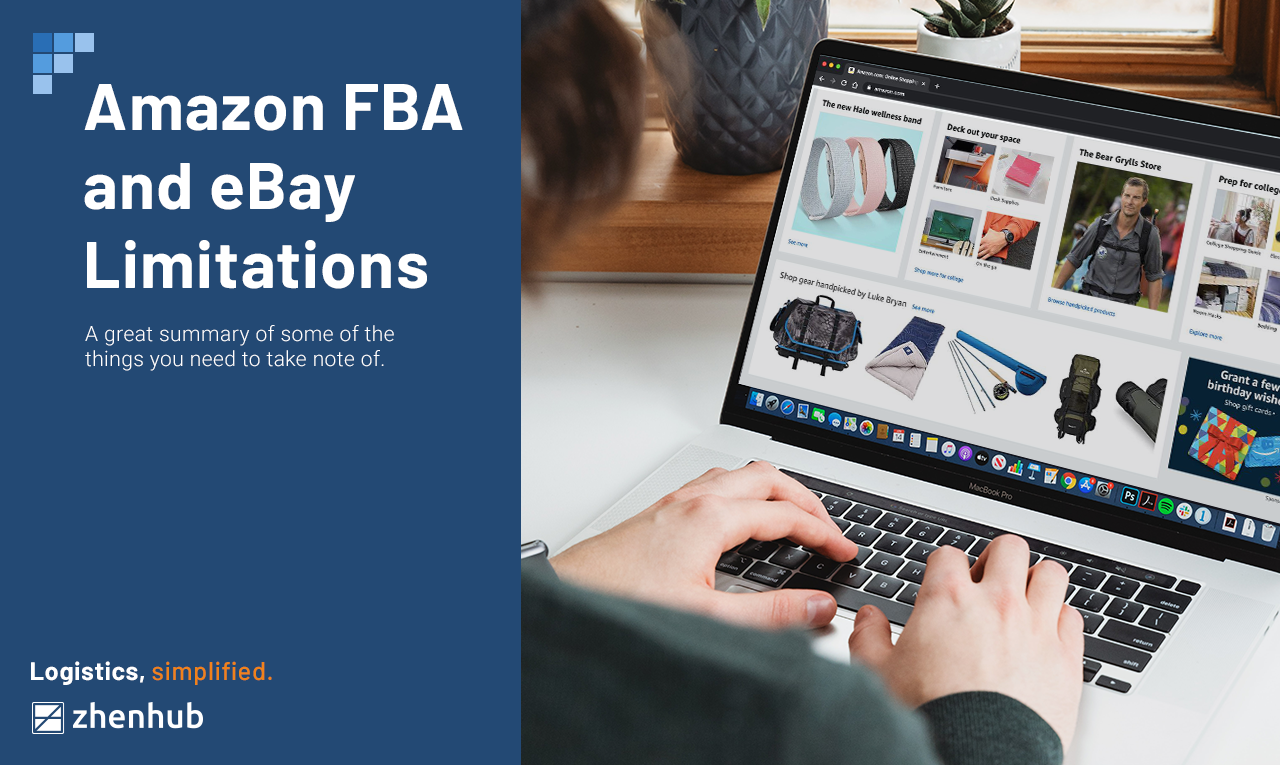
Amazon FBA and eBay Limitations (Updated 2020)
Time to read: 7 minutes
Reading time: 2 min 45 sec
This article was updated on Sept 2020.
Amazon FBA and eBay Limitations
As online merchants, choosing a fulfillment company can make or break your business. Whether you are an established seller or a first-time entrepreneur, you are probably familiar with eCommerce giants Amazon FBA and eBay. In this article, we are going to get down to the details of these two eCommerce shipping powerhouses, focusing on both Amazon FBA and eBay limitations.
What is Amazon FBA?
FBA stands for Fulfillment by Amazon, a service wherein online merchants can sell their products and Amazon FBA will handle storing, picking, packing, and shipping the orders. This also means that you get to enjoy Amazon FBA’s reliable customer service to help you manage inquiries, refund and return requests; all with no extra charge.
What is eBay?
Similar to Amazon FBA, eBay also offers fulfillment services. Signing up this will allow online marketplace merchants to get eBay’s assistance when it comes to receiving, product inspection, inventory storage, order fulfillment, shipping, returns, kitting or assembly.
Amazon FBA and eBay Limitations: A Comparison
Since both shipping giants practically offer the same service to online sellers, here is a quick comparison between Amazon FBA and eBay limitations that you need to consider before choosing one over the other.
Seller Fees
Amazon FBA Fees
Amazon FBA fees vary based on the product you are selling. As an online merchant, you will be responsible for what is called “Selling on Amazon Fees” which include referral fee, variable closing fee, and a fulfillment by Amazon fee which is calculated based on your product’s weight and dimensions. In addition to that, you will also have to take into account the monthly storage and fulfillment fees.
Lastly, as an Amazon FBA seller, you can choose between two seller accounts- individual, which will incur $0.99 fee per unit sold; and professional, which will inquire a monthly subscription fee of $39.99. Refund administration fees, which are charged at either $5.00 or 20% of the refunded charge (whichever is less) will also come into play in the event a customer of yours requests a refund.
eBay Fees
For eBay, sellers will have to consider insertion fees, which are charged when you create a listing on their site; however, you are entitled 50 listings free of insertion charges every month. Now, every time a product of yours gets sold, eBay will take a percentage depending on the item’s final sale price, including shipping and handling, but minus the sales tax.
eBay also charges sellers for Payment processing, but the amount will vary based on whether or not you signed up for their “Managed Payments” service. If you did, then this will be included in the Final Value fee, but if you choose to use PayPal to process customer payments, then you just have to prepare for a $0.30 fee in addition to the 2.9% of the item’s total selling price, including sales tax.
You can also pay upgrade fees if you want to customize a particular listing. This is best for limited offers or featured products because it will allow you to add bold fonts, subtitles, and set a minimum or reserve price for the item listed.
Seller Restrictions
Amazon FBA Inventory Limit
Amazon FBA recently implemented a 200-unit limit for seller inventory. This means that online merchants can only send 200 units of a new product into Amazon’s fulfillment centers. The restriction, which officially took effect on August 16, 2020, will last until December 31, 2020. Amazon FBA decided to introduce the limitation in light of the COVID-19 pandemic that resulted in an increase in demand at the eCommerce platform.
Implementing the 200-unit limit is the company’s way of making sure fulfillment centers are still managed at optimum efficiency. To know how you can deal with this new inventory limit, just click on this link.
Amazon FBA Product Categories
When it comes to product categories, Amazon FBA splits types into three: Ungated, or product categories that are open to all sellers right off the bat; and Gated, which are product categories that require approval from Amazon; and Restricted. Here’s an updated list of products that fall under each category:
| Ungated Categories | Gated Categories | Restricted Categories |
|
|
|
*May have restrictions during holiday season
** May have sub-category restrictions
^ Not included on Amazon’s current list of restricted products, but have restrictions
Please also note that listing products that claim they are FDA-cleared or approved, or have an FDA logo on the image uploaded are prohibited as well.
eBay Inventory Limit
eBay has a three-tier selling limit structure: account-based which are limitations placed on the seller, category-based limits which are restrictions on certain product categories, and item-based which are limits placed on specific products or items.
These limits usually depend on your status as a seller under eBay which are based on particular performance metrics which includes items sold, active selling history, customer reviews, and timely deliveries, among others. However, for new eBay sellers, the limit usually starts at 10 items per month, with value totalling of $500. You can apply for an increase in seller limits as you establish your online shop.
eBay Product Categories
eBay limitations on product categories is quite similar to Amazon FBA in the sense that it is also categorized into three: allowed which are open to all, prohibited which are not accepted at all, and restricted which can be listed under certain conditions and approvals. Here’s a quick list for reference:
| Allowed Categories | Prohibited Categories | Restricted Categories |
|
|
|
For an updated list of all, changed, new, moved, renamed, and retired categories, just click here.
Branding Control
When it comes to branding, eBay provides more flexibility because it provides you, the seller, access to the email address of your customers. This will allow you to create marketing campaigns directly targeted to your previous or existing customer base, which you can use to promote your store, listings, and brand.
Amazon FBA, on the other hand, practically owns your customer base. You will not have access to their email addresses and you are bound in terms of how you can brand your product listings since limitations are in place for their HTML and CSS.
Advertising Capabilities
Amazon FBA Sponsored Products
If you want to feature a specific product in your shop, Amazon FBA can secure you a first-page spot for particular keywords you can either set yourself or have Amazon automate. Amazon FBA offers Sponsored Products which is a pay-per-click service wherein you are only charged every time your listing gets clicked.
You can easily manage your ads through Amazon FBA’s in-house apps and tools. You can also explore other advertising options of Amazon FBA which are aimed at brand and affiliate promotion.
eBay Promoted Listings
eBay also offers Promoted Listings, which can effectively boost your chosen products when users do a search on the eCommerce platform. Promoted Listings’ structure is in “bids”, where you pay a particular amount in addition to your final value fee (around 5 to 10% commonly). Doing so will boost your product together with other bidders. The main difference between Amazon FBA and eBay’s advertising structure is that with the latter, you will only get charged when you successfully sell an item.
Market Reach
In terms of market reach, you will go far with Amazon FBA as they have more users than eBay. In fact, a study by Feedvisor has revealed that 66% of consumers often rely on Amazon when starting their search for new products more so than search engines like Google. However, it is also important to note that Amazon FBA also houses more sellers than eBay, which means competition is higher.
Amazon FBA and eBay: Which one is right for you?
It is evident in all topics covered that while there is a lot to consider in terms of Amazon FBA and eBay limitations for sellers and online merchants, both platforms have their own set of advantages and disadvantages.
At the end of the day, it will all depend on what you wish to prioritize as a seller. If flexibility and ease of listing are what you are after, then eBay might be the right fit for you. However, if you are looking to reach a wider market and bank on Amazon FBA’s established trust rate to boost your shop, then you are better off with Amazon FBA.
Also, do not forget that you are not limited to choosing just between the two! As an online merchant, it is best to explore your options by checking out other eBay and Amazon FBA alternatives, too.
If you need any assistance with navigating eCommerce shipping platforms, do not hesitate to contact our specialists here at Zhenhub!


